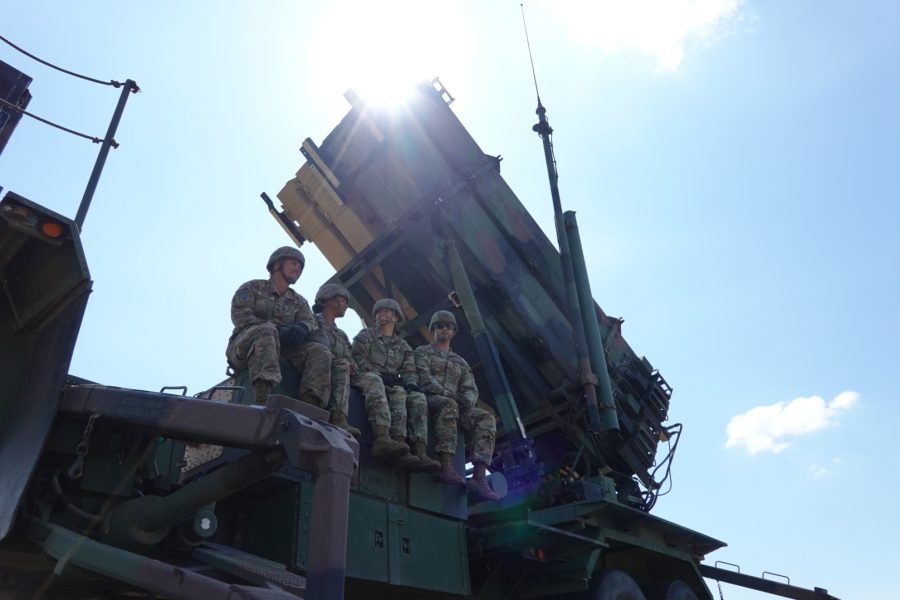Russia’s invasion of Ukraine has reinforced the need for America and its allies to maintain control of the skies in a conflict, top U.S. Army officials said June 23.
“We’re going to have the ability to provide or assist in providing a no-sail zone, and as we develop our air and missile defense capability and integrate it, the ability to have a no-fly zone,” Army Chief of Staff Gen. James C. McConville told reporters on a conference call after a meeting of top officers from U.S. and European land forces in Germany.
Over Ukraine, neither side has been able to achieve air superiority due to each side’s effective ground-based air defenses. McConville, a former Army helicopter pilot, said the U.S. cannot let an adversary get the upper hand in the air or overwhelm its air defenses with relatively cheap drones as Russia has tried to do to Ukrainian by using Iranian-designed drones to pummel Ukrainian infrastructure. That tactic has strained Ukraine’s air defenses and forced the West to keep restocking its capabilities with pricey interceptors.
“That’s certainly a concern there,” McConville, joined by the boss of U.S. Army Europe Gen. Darryl A. Williams, said after the Conference of European Armies, which brought together 33 European army chiefs, including from Ukraine. While the U.S. Army Chief is soon retiring, he hopes the next generation of air defenses will be able to defeat targets with the appropriate weapons.
The U.S. has many advanced air defense systems, such as PATRIOT batteries, THAAD systems, and so-called SHORAD, which comprise a myriad of short-range air defense systems, which the Army has been reinvesting in.
An issue for Ukraine has been making its patchwork system of Western-provided air defense knit together. But the U.S. hopes that it can create a more coordinated system for itself.
“We’re in the process of fielding our Integrated Battle Command System that ties these sensors together, and we are working very closely with our allies and partners in the region to make sure that their systems integrate into our systems,” McConville said. Ground-based air defense is not just a problem for the Army—the systems McConville ticked off are vital components of U.S. military plans to protect critical sites such as Guam, which serves as a significant Air Force hub in the Pacific.
While the U.S. military still sees a need for armor and infantry, the Army boss said, the conflict in Ukraine has highlighted the “game-changing” abilities of long-range precision fires, such as those from HIMARS launchers.
“We’re certainly seeing the value of long-range fires and how that works,” McConville said. “The ability to target logistics is something that we all know is extremely important.”
Nor are all of those long-range capabilities ground-based. The longest-range precision weapons system Ukraine has right now is an air-launched cruise missile, the British Storm Shadow, which has reportedly been used against key targets during Kyiv’s counteroffensive. Storm Shadows have a range of over 300 miles, roughly in line with JASSM air-to-surface and related LRASM anti-ship cruise missiles that the Air Force plans to buy as much of as possible.
It has now been around a year since the U.S. provided much-lauded HIMARS launchers to Ukraine, though with the limitation of using GMLRS rockets, which have a range of roughly 50 miles, rather longer-range ATACMS missiles. But Storm Shadows from the U.K. and JDAM-extended range guided bombs from the U.S. have increased Ukraine’s strike range from the air.
Those long-range weapons provide the “ability to put logistics at risk and command posts at risk and help shape the battlefield for the close combat events that will happen afterward,” said McConville.
But despite Western efforts to aid Ukraine’s air defense and enhance its long-range strike capabilities, Russian airpower is returning, particularly with attack helicopters that have been used to help blunt Ukrainian advances since the counteroffensive began earlier this month. Meanwhile, Kyiv is still awaiting Western decisions on where and when to begin training Ukrainian pilots on F-16s.
“One the biggest challenges we are facing on the ground is the dominance of Russia in the air,” Ukrainian foreign minister Dmytro Kuleba told the BBC on June 23.
